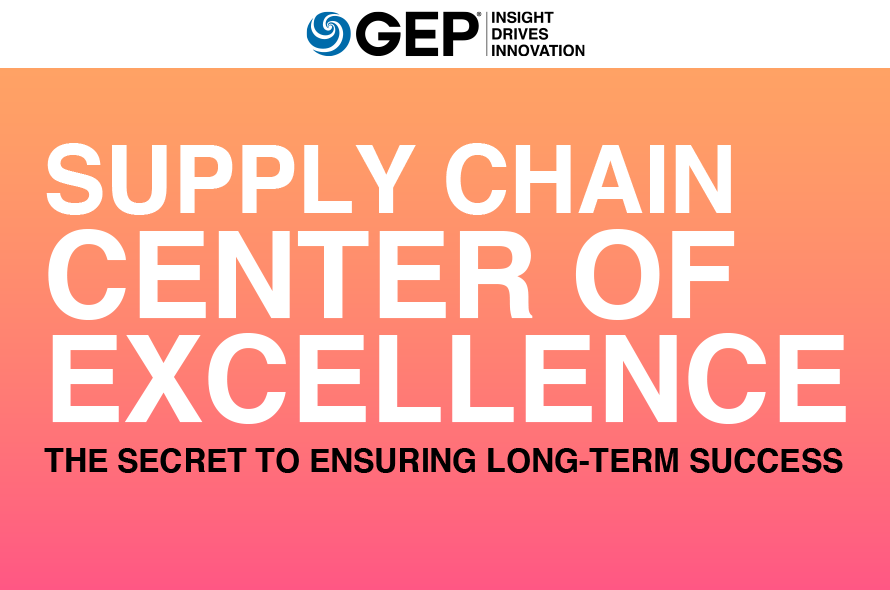By design, taskforces help navigate specific disruptions. As we return to a semblance of normalcy, CSCOs may be tempted to rename these specialized teams supply chain centers of excellence (CoEs).
But it’s the wrong move.
This GEP Bulletin — Supply Chain Center of Excellence: The Secret to Ensuring Long-Term Success — outlines why reconstituted taskforces won’t work as CoEs. You’ll also get a blueprint for maximizing the long-term impact of CoEs.
What’s Inside:
- Resisting the urge to repurpose taskforces as CoEs
- Defining the CoE’s function post-pandemic
- Building a CoE model that adds tangible value
The paper is a must-read for CSCOs looking to develop an agile response to supply chain disruptions.
In the past, many enterprises created supply chain Centers of Excellence (CoEs) only to reduce or eliminate them when cost pressures rose. As a result, a majority of CoEs closed.
Recently, many enterprises have created cross-functional task forces to navigate the uncertainty caused by the COVID-19 pandemic. GEP recommended this in our COVID-19 handbook.
These taskforces have since stepped up to manage additional disruptions, from Brexit to trade wars to a ship stuck in the Suez Canal. As the world begins to emerge from the pandemic, some enterprises are converting their task forces into supply chain CoEs. Will these task forces, which have proven invaluable during the pandemic, have lasting success as CoEs?
We believe that if the task force is simply renamed a CoE, it is destined to fail. To succeed in the long term, corporations need to take a step back to identify driving factors and a CoE business model that remains relevant when the original driving factor — in this case, the pandemic — subsides.
Short-term Motivations Cannot Ensure Long-Term CoE Success
Renaming the task force to a CoE may seem like an easy fix, but it will hurt the long-term relevance of the CoE.
A chief supply chain officer (CSCO) may reasonably conclude that their COVID-19 (or any other) task force should be converted into a permanent supply chain CoE. Some motivations may include:
- The task force has been invaluable during the pandemic.
- Disruption is becoming a norm, and such a task force is needed perpetually.
- This is an effective team that has networked across BUs in the last year.
- No change needed in cost apportioned to each BU.
- The team has gained knowledge about all aspects of the supply chain and is well suited to serving as a CoE.
All of the above are reasonable arguments, so the task force is renamed to a CoE. They jump in when the Suez Canal traffic jam causes a disruption, or when COVID-19 spikes in several regions spark additional lockdowns. Then, a year passes without any major disruptive event.
However, over this year, competitors show bigger improvements in profitability. Leadership asks the right questions about this, and the CoE is deployed to cut costs. It manages to reduce some costs but has limited influence. Ultimately, leadership asks why this CoE exists if it cannot optimize costs quickly.
The CSCO’s answer includes the CoE’s past contributions and how effective the team was, but also how difficult it was to reduce costs further without BU support. This answer does not appeal to leadership, so they ask the BUs if they can live without the CoE. Eager to not be given additional cost reduction targets, the BUs agree. So, leadership decides that the CoE must be disbanded.
Making the Long-Term Business Case
Consider another CSCO, who begins by asking the question “What will be this CoE’s purpose in a post-pandemic, steady state environment?” A plethora of potential roles come up, which are divided into three buckets:
Standardization
- Master data and SKU nomenclature standards.
- Enterprise third-party spend data taxonomy.
- Inventory management and risk management framework.
Standardization has clear benefits to the enterprise in terms of harmonization and visibility. This is used to create a clear business case and bring in an external partner for the one-time effort of setting up the standards and driving change. The CoE only needs a small internal team later for maintaining/updating the standards.
De-Duplication
- Evaluate supply chain technology, run pilots and own the long-term technology road map.
- Identify and automate duplicate processes manually executed in BUs.
- Eliminate duplicate spend analysis, supplier discovery and duplicate sourcing efforts by establishing preferred providers for materials and services needed across BUs.
These processes are brought into the CoE’s ambit only if they have a clear long-term business case (higher savings from enterprise leverage, enterprise inventory visibility, BU resources freed up, etc.) Further, the focus is on technology and automation, so the CoE does not bulk up with resources. The technology licenses themselves are funded by the BUs.
Execution
- Project manager pool for large capital projects in any BU.
- Planning teams for ongoing demand planning for BUs.
- Procurement resource pool for sourcing of direct materials for BUs.
This area must be looked at most critically. It is tempting to create pools of expert resources in several areas, but at any given time, the BU facing the most cost pressure is likely to balk at the overhead imposed — especially because that BU is unlikely to have major capital projects and other such activity. So, the model chosen is to have preselected external partners in each area. The CoE can still rapidly mobilize for a specific project, but with a clear business case and cost tied to that project rather than the CoE.
Overall, the CSCO still manages to absorb most of the COVID task force into this lean CoE, with the rest of the resources returning to their BU roles. When the time comes to cut costs, this CoE can prove that it is already very lean. Reducing any resources will directly add more costs to the BUs overall than will be saved. Further, the CoE owns areas such as sourcing, which can contribute significantly to the enterprise cost reduction targets. This response is more to management’s liking, and the CoE survives the cost-cutting scalpel.
Conclusion
CoEs are becoming more and more relevant as technology, enterprise visibility and resilience take center stage. But the CoE’s foundation must be sound.
We believe the wrong way to create a supply chain CoE is to repurpose a task force created to address a single acute need. As that acute need subsides, there is risk that the CoE itself will lose significance.
The right way to create a CoE is to carefully define its scope and functions honestly and thoroughly, determining the tangible value the CoE will deliver and adopting an agile model of delivery that does not impose a fixed burden on BUs. Such a CoE can remain perpetually relevant.
We believe the CoE must own crucial aspects of the supply chain such as technology road maps and data standards. This CoE should also tap into a network of prequalified external partners for execution.
This approach ensures that the best-fit expertise can be brought in for each project as needed. This way, costs can be directly apportioned to the consuming BU instead of the CoE. These steps help confirm that the CoE will survive in difficult times and continue to provide tangible benefits to the organization.
TURN IDEAS INTO ACTION. TALK TO GEP
GEP helps enterprise procurement and supply chain teams at hundreds of Fortune 500 and Global 2000 companies rapidly achieve more efficient, more effective operations, with greater reach, improved performance, and increased impact. To learn more about how we can help you, contact us today.
LET'S CONNECT
Pranav Padgaonkar
Senior Director, Consulting, GEP
Pranav is a Sr. Director in the Consulting Practice, and brings with him 17 years of extensive experience covering a broad spectrum of procurement and supply chain capabilities. He leads large consulting engagements focused on cost reduction, using digital transformation, strategic sourcing and supply chain optimization to deliver transformative results.

